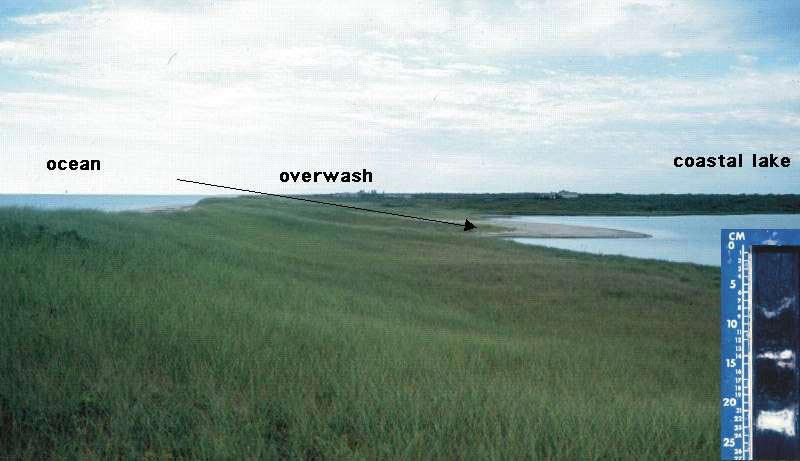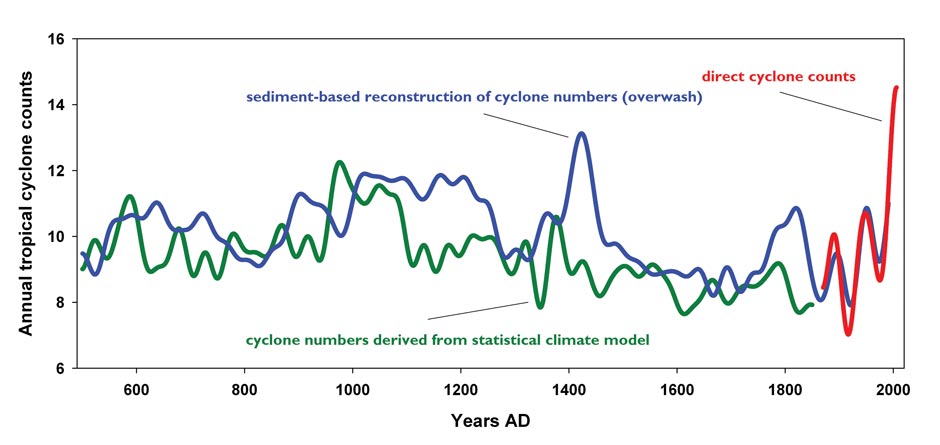Warmer future, stronger hurricanes?
Caribbean hurricane history shows that medieval cyclone peaks rivaled current ones
The above graph shows annual numbers of tropical cyclones in the Atlantic over the past 1,500 years. Actual counts (direct observations) of hurricanes since AD 1850 are shown in red. Hurricane numbers before that date are based on statistical model estimates and on sediment-based reconstructions of tropical cyclone activity.
The statistical model estimates of hurricane counts for the period before AD 1850 have been derived from climate indices based on proxy data for climate (AD 500-1850; green). Hurricane numbers per year have also been reconstructed from sedimentary records of hurricanes that made landfall in the Western Atlantic (AD 500-1991; blue).
Some standard statistical procedures have been performed; e.g., the hurricane counts are smoothed to provide better visibility of the data in the graph.
The data show a current peak in hurricane activity (red), but also a similar peak in medieval times (AD 900-1100). That the latter is present in both the model-predicted (green) and the sediment-reconstructed (blue) curves suggests that it can be explained by climate forcing. We do not yet fully understand all factors affecting hurricane dynamics, but the records show that warm Atlantic surface temperatures are associated with more hurricanes, and current global warming is also warming the oceans.
Whether the current surge of hurricanes is attributable to climate change or not, increased use of coastal zones has created new vulnerabilities, and measures need to be taken to prevent more human losses and destruction of assets.
Snapshot 2 – The Story
Many people believe that the climate is getting worse. Events such as the floods in New Orleans in the wake of hurricane Katrina in 2005, which killed more than 1,300 people, seem to support this view. But is it true? Has the number and strength of hurricanes really increased?
To answer that question, scientists in an IAI-funded project, Jeffrey Donnelly from Woods Hole Oceanographic Institution and his colleagues at Pennsylvania State University, compiled a dataset of Atlantic hurricane activity over the past 1500 years. Their evidence is based on so-called ‘proxy’ data. Proxy data means that, as past hurricanes cannot be directly observed anymore, the team used indirect estimates. These estimates are either derived from statistical climate models that use proxy data for such climate variables as air or ocean temperature; or from sediments that are deposited when hurricanes make landfall and ocean water floods into the coastal lagoons or lakes, the so-called ‘overwash’ (figure on this page). This unique data set ranges from New England to Puerto Rico, covering the Western Atlantic.
The results, published in the scientific journal Nature, suggest that Atlantic hurricane activity peaked during medieval times (ca. AD 900-1100), but calmed down afterwards, notably after AD 1500, to take up speed again after 1850, and especially, after 1980. The medieval peak rivals the recent levels of hurricane activity. The medieval peak is associated with a period of warm Atlantic sea surface temperatures (SSTs), while the period of low hurricane activity partially coincides with the Little Ice Age from the 16th to 19th centuries. This study helps understand the climate factors that determine Atlantic hurricane activity, and hence, may help forecast risks.
 Paleotempestology, the science of ancient storms, examines coastal lakes behind sandy barriers to look for evidence of hurricanes.
Paleotempestology, the science of ancient storms, examines coastal lakes behind sandy barriers to look for evidence of hurricanes.
During hurricane landfall, high waves driven by the storm, surge over the sand barrier and wash sand into the coastal lake, forming what geologists call an overwash fan that appears as a sand layer (white bands in inset), distinct from the fine organic mud that accumulates under normal conditions. These layers can be seen in sediment cores and provide information about the number and strength of prehistoric storms (see the article by Kam-biu Liu published in American Scientist).
Further reading
Mann, Michael E., J.D. Woodruff, J.P. Donnelly, and Z. Zhang (2010) Atlantic hurricanes and climate over the past 1500 years. Nature, Volume 460, pages 880-883.
Liu, Kam-biu (2007) Uncovering prehistoric hurricane activity. American Scientist, Volume 95, pages 126-133.
Global Change Science Snapshots are intended to inform
IAI clients and the interested public about important results
of international research carried out under IAI auspices.
Editorial Board: Christopher Martius, Ione Anderson, Paula Richter, Holm Tiessen
Design: Shadi Ardalan
Cite as: IAI (2010) Warmer future, stronger hurricanes? Caribbean hurricane history shows that medieval cyclone peaks rivaled current ones. Science Snapshots, 2. IAI, Brazil.
Link to IAI Project
CRN 2050

